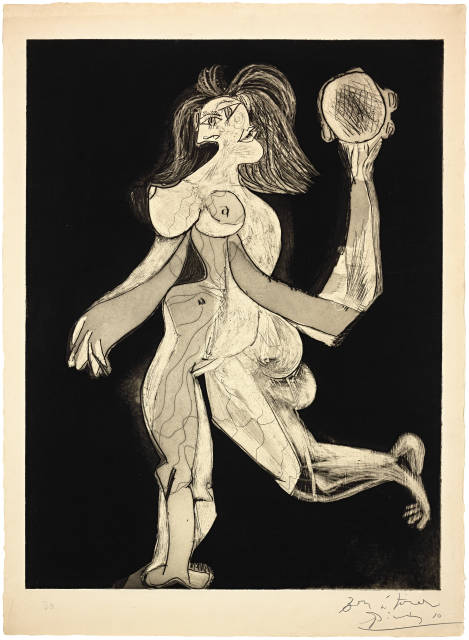- EN
Log in
- Live Auctions
- Past auctions
- More
- Gallery
- Art Dealing
- Publishing
- Kornfeld today
- The Story of Kornfeld
- Information




Paris 1939
Aquatint and mezzotint on wove paper
66.5x51.3 cm, platemark; 76.9x57 cm, sheet size
Inscribed and signed "Bon à tirer / Picasso" in pencil by the artist lower right, inscribed "30" in an unknown hand on the left
Baer 646/V/A/b (of C), one of the specimens mentioned there
Bloch 310
Estate of Roger Lacourière, Paris, acquired there by
The Eberhard W. Kornfeld Collection, Bern, with the collector's stamp on the reverse, Lugt 913b
Salzburg/Winterthur 1984/1985, Rupertinum/Kunstmuseum, Von Goya bis Warhol, Meisterwerke der Graphik des 19. und 20. Jahrhunderts aus einer Schweizer Privatsammlung, cat. no. 196, ill.
Cologne 1988, Museum Ludwig, Picasso im Zweiten Weltkrieg 1939 bis 1945, cat. no. 61, ill. p. 57 and p. 227
Hovikodden 1992, Sonja Henie-Niels Onstad Foundations, Picasso
Fribourg 1994, Musée d'art et d'histoire, Pablo Picasso, Gravures et lithographies, cat. no. 167, ill. and ill. p. 153
San Francisco/New York 1998/1999, California Palace of the Legion of Honour/Guggenheim Museum, Picasso and the War, cat. no. 26
Bern 2001/2002, Kunstmuseum, Picasso und die Schweiz, cat. no. 129b, p. 371
Hamburg 2002/2003, Bucerius Kunst Forum, Picasso und die Mythen, cat. no. 169, p. 255, ill. p. 221
Bern 2010, Zentrum Paul Klee, Klee trifft Picasso, ill. p. 215, p. 277
Slight traces of the printing process, minimal rubbing in the black and at the upper margin. Beautiful, velvety impression with a lot of burr
The relationship between Dora Maar and Pablo Picasso is one of the most turbulent love stories in 20th century art. Maar, who worked as a surrealist photographer, met Picasso in Paris in 1935/1936. Picasso was fascinated by Maar's self-confidence and striking presence. She became his constant companion and documented, among other things, the creation of his epochal painting on the Spanish Civil War, "Guernica". In 1939, after the long and bloody war, Picasso turned to his immediate surroundings for inspiration. He created many still lifes, but his main subject was his new muse Dora Maar. He portrayed her in most artistic media: painting, drawing, sculpture and printmaking.
The partnership lasted almost a decade and was characterised by intellectual exchange and intense passion. Maar's influence on Picasso during these years led to some of his most iconic and daring portraits - including the aquatint "La femme au tambourin".
Our work is executed in a similar tonality and nuance to "Guernica". Working in black, white and shades of grey, Picasso was able to bring a painterly aspect to the print. He masterfully succeeds in emphasising light and expression. The aquatint provides an insight into Picasso's private life, but also opens a window on current world events. Brigitte Baer describes it as "encrage plus doux", or "softer colouring". The "Bon à tirer" is the reference sheet approved by the artist, according to which the printers, in this case Roger Lacourière, were able to print the edition in precisely this quality and colouring. Lacourière probably noted the edition "30" on the left. In this respect, the "Bon à tirer" are always very special sheets, the culmination of the realisation and the printing process, so to speak.
Paris 1939
Aquatinta und Schabeisen auf Kupfer auf Velin
66,5x51,3 cm, Plattenkante; 76,9x57 cm, Blattgrösse
Unten rechts vom Künstler in Bleistift bezeichnet und signiert "Bon à tirer / Picasso", links von fremder Hand bezeichnet "30"
Baer 646/V/A/b (v. C), eines der dort erwähnten Exemplare
Bloch 310
Nachlass Roger Lacourière, Paris, dort erworben von
Slg. Eberhard W. Kornfeld, Bern, rückseitig mit dem Sammlerstempel, Lugt 913b
Salzburg/Winterthur 1984/1985, Rupertinum/Kunstmuseum, Von Goya bis Warhol, Meisterwerke der Graphik des 19. und 20. Jahrhunderts aus einer Schweizer Privatsammlung,
Köln 1988, Museum Ludwig, Picasso im Zweiten Weltkrieg 1939 bis 1945,
Hovikodden 1992, Sonja Henie-Niels Onstad Foundations, Picasso
Fribourg 1994, Musée d’art et d’histoire, Pablo Picasso, Gravures et lithographies,
San Francisco/New York 1998/1999, California Palace of the Legion of Honor/Guggenheim Museum, Picasso and the War,
Bern 2001/2002, Kunstmuseum, Picasso und die Schweiz,
Hamburg 2002/2003, Bucerius Kunst Forum, Picasso und die Mythen,
Bern 2010, Zentrum Paul Klee, Klee trifft Picasso,
Leichte Spuren des Druckprozesses, im Schwarz und im oberen Blattrand minime Bereibungen. Schöner, gratiger und samtener Druck
Die Beziehung zwischen Dora Maar und Pablo Picasso ist eine der turbulentesten Liebesgeschichten in der Kunst des 20. Jahrhunderts. Maar, die als surrealistische Fotografin arbeitete, lernte Picasso 1935/1936 in Paris kennen. Picasso war fasziniert von Maars starkem Selbstbewusstsein und ihrer beeindruckenden Präsenz. Sie wurde zu seiner ständigen Begleiterin und dokumentierte unter anderem die Entstehung seines epochalen Gemäldes zum Spanischen Bürgerkrieg, "Guernica". Nach dem langen und blutigen Krieg suchte Picasso 1939 in seiner unmittelbaren Umgebung nach Inspiration. Es entstanden viele Stillleben, doch sein Hauptmotiv wurde seine neue Muse Dora Maar. Er porträtierte sie in den meisten künstlerischen Medien: Malerei, Zeichnung, Skulptur und Druckgraphik.
Die Partnerschaft dauerte fast ein Jahrzehnt und war geprägt von intellektuellem Austausch und intensiver Leidenschaft. Maars Einfluss auf Picasso in diesen Jahren führte zu einigen seiner ikonischsten und gewagtesten Porträts – darunter auch die Aquatinta "La femme au tambourin".
Das Blatt ist in einer ähnlichen Tonalität und Nuancierung wie "Guernica" ausgeführt. Die Arbeit in Schwarz, Weiss und Grautönen ermöglichte es Picasso, einen malerischen Aspekt in die Druckgraphik zu bringen. Meisterhaft gelingt es ihm, Licht und Ausdruck besonders hervorzuheben. Die Aquatinta gewährt einen Einblick in Picassos Privatleben, öffnet in der Art der Umsetzung aber auch ein Fenster auf das aktuelle Weltgeschehen. Brigitte Baer schreibt über das hier angebotene Blatt "Encrage plus doux", also "weichere Einfärbung". Das "Bon à tirer" ist jeweils das vom Künstler freigegebene Referenzblatt, nach welchem die Drucker, hier Roger Lacourière, die Auflage in genau dieser Qualität und Ausprägung drucken konnten. Links hat Lacourière wohl die Auflage "30" notiert. Insofern sind die "Bon à tirer" immer ganz besondere Blätter, quasi der Höhepunkt der Umsetzung und des Druckprozesses.
| Switzerland | CHF | 170 |
| Europe | CHF | 285 |
| Overseas | CHF | 380 |





